In This Guide
Search Engine Optimization, better known as SEO, is a multifaceted discipline that operates at the intersection of technology, marketing, and user experience. It’s a key strategy in digital marketing and an essential tool for any business looking to boost their online presence. This article kicks off our comprehensive series diving deep into the world of SEO, beginning with the basics and leading you towards mastering complex strategies like keyword research, on-page and off-page optimization, technical SEO, mobile SEO, and much more.
Defining SEO Basics
SEO is the practice of optimizing your online content to make it more visible to search engines. It’s about understanding what people are searching for online, the answers they’re seeking, and the type of content they wish to consume. Knowing the answers to these questions allows you to connect to the people searching online for the solutions you offer.
At its core, SEO is about visibility and rankings. The higher your website ranks in search engine results pages (SERPs), the more likely people will click and visit your site. But it’s not just about getting any visitor; it’s about attracting the right visitors who are genuinely interested in what you offer.
The Role of Keywords in SEO
What are Keywords in SEO?
Keywords are integral elements in the realm of SEO as they act as pivotal connectors between the search queries of users and the content available on your website. They are not mere words but significant tools that search engines utilize to locate your content among the vast expanses of the internet. By effectively aligning your content with popular and relevant keywords, you can enhance the visibility of your website exponentially.

The Importance of Keywords
The prominence of keywords in the SEO sphere cannot be overstated. To illustrate, imagine the internet as an immense library and the search engines as librarians. In this context, keywords are the cataloging system that helps the librarian find the exact book a reader is looking for. Without keywords, the librarian would have to browse through every single book, which is practically impossible considering the size of the library.
Therefore, a significant part of your SEO strategy should involve meticulous research and selection of suitable keywords. This process is not just about identifying the most searched terms but understanding the intent behind these searches. It’s about getting into the mind of your target audience, comprehending their language, their needs, and their search behavior. When you gain this understanding, you can tailor your content to meet these specific requirements, thereby increasing the likelihood of your website appearing in their search results.
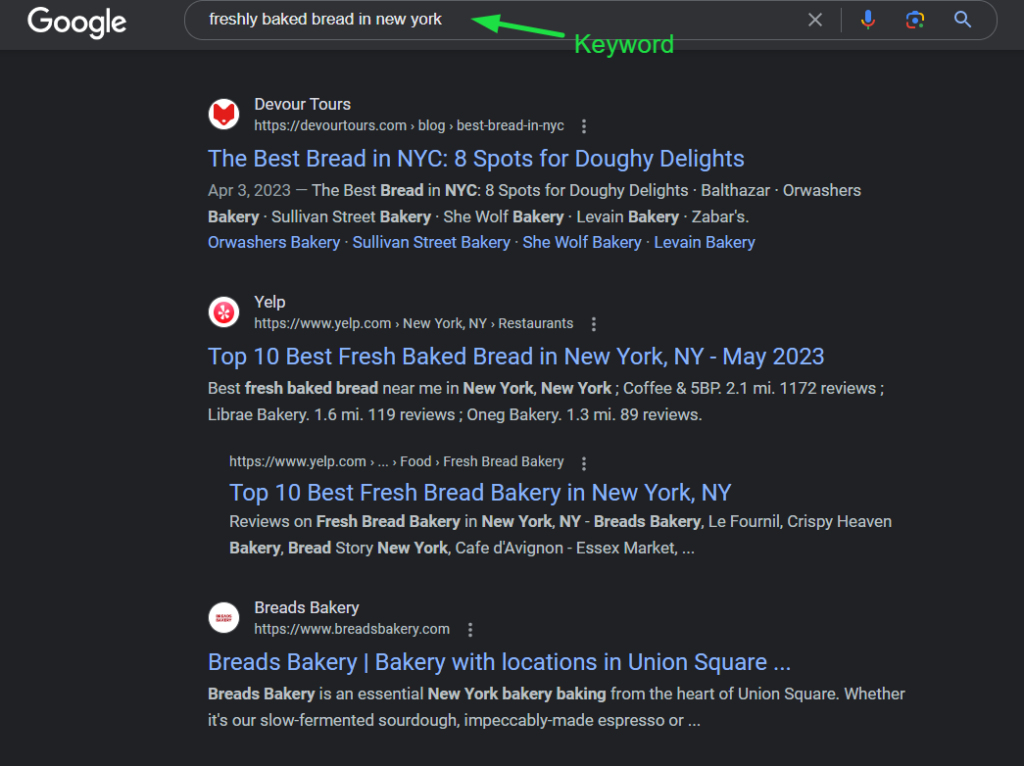
For example, a New York bakery aiming to attract customers might focus on keywords such as “best bakery in New York,” “freshly baked bread in New York,” or “custom birthday cakes in New York.” These targeted keywords, relevant to the business, are likely to be used by potential customers. Incorporating these in your content can enhance search engine recognition of your website, possibly boosting your rankings and visibility.
Table: Types of Keywords in SEO
| Keyword Type | Description | Example |
|---|---|---|
| Short-tail | General, broad terms | "Bakery" |
| medium-tail | More specific, often a combination of two or three terms | "Custom birthday cakes" |
| Long-tail | More specific, often phrases | "Best gluten-free bakery in town" |
| Local | Geographically specific | "Freshly baked bread in Chicago" |
| LSI (Latent Semantic Indexing) | Related or synonymous terms | "Pastry shop", "bread store" |
Understanding On-Page SEO
On-Page SEO is a critical component in the SEO process. It involves optimizing the elements within your website, which includes the content and the HTML source code of individual pages.
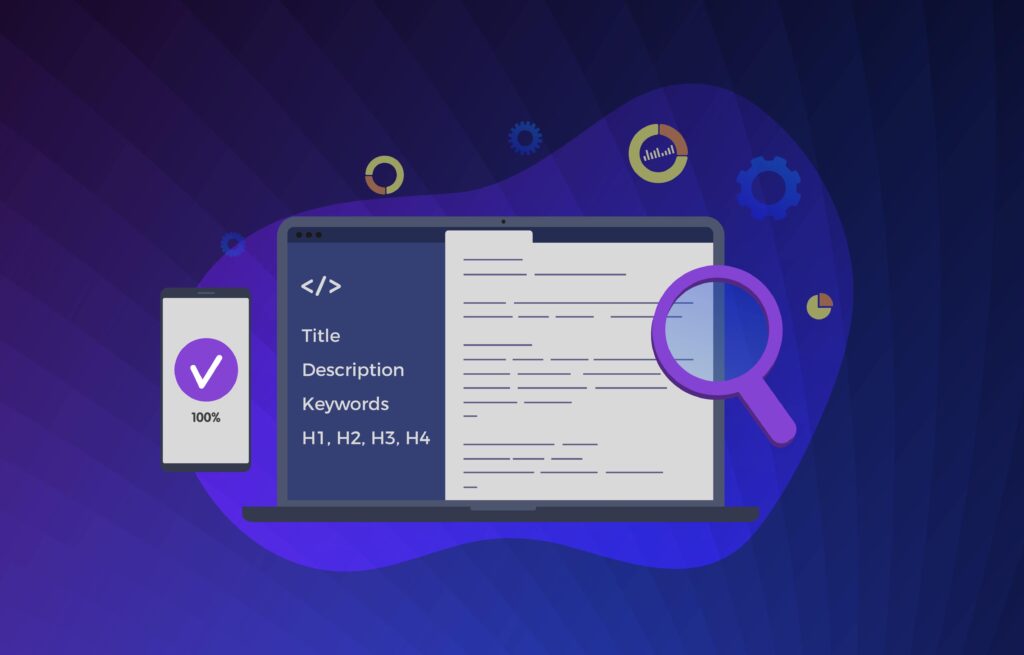
- Quality Content Creation: The cornerstone of on-page SEO is high-quality, original content that provides value to your audience. This content should be relevant to your industry, informative, and engaging to encourage users to spend more time on your website.
- HTML Tag Optimization: HTML tags such as title tags, meta descriptions, and header tags should be optimized to include relevant keywords. These tags provide search engines with context about your page’s content.
- Keyword Utilization: Effective use of keywords in your content, including the title, headers, and the main body of the text, can help search engines understand your content better. It’s essential to strike a balance, however; overuse of keywords can lead to penalties from search engines.
- User-Friendly Design: Your website’s design should be intuitive and user-friendly. This includes factors such as load speed, mobile responsiveness, and easy navigation, all of which can affect your search engine rankings.
Table: Types of Keywords in SEO
| Element | Description |
|---|---|
| Title Tag | The title of your webpage, which should include the target keyword. |
| Meta Description | A brief description of the page content, which can influence click-through rates. |
| Header Tags | HTML elements (H1, H2, etc.) used to identify headings and subheadings. |
| Keyword Density | The frequency of your keyword appearing in your content. |
Understanding Off-Page SEO
Off-Page SEO involves activities carried out outside of your website that enhance its visibility and ranking on search engines.

- Backlink Building: The cornerstone of off-page SEO is building high-quality backlinks from reputable websites. These links signal to search engines that your content is valuable and trustworthy.
- Domain Authority: The Number of high quality backlinks determine your website’s domain authority—a measure of a site’s trustworthiness and relevance. Websites with a higher domain authority are more likely to rank higher on search engine results pages.
- Social Media and Guest Blogging: Other off-page SEO strategies include social media marketing, where you can build your brand’s online presence and drive traffic to your website. Guest blogging allows you to reach a wider audience by publishing content on other websites and linking back to your site.
Table: Types of Keywords in SEO
| Element | Description |
|---|---|
| Backlinks | Links from other websites to your own. A high number of quality backlinks can improve your domain authority. |
| Social Signals | Shares, likes, and comments your content receives on social media. |
| Brand Mentions | Instances where other websites or social media profiles mention your brand or website. |

Example: A website that has effectively utilized both on-page and off-page SEO is Moz, a popular SEO software company. Moz’s website contains high-quality, keyword-rich content (On-Page SEO), and has a high domain authority due to numerous backlinks from reputable sources, and a strong presence in social media and guest blogging platforms (Off-Page SEO).
Technical SEO
Technical SEO refers to the practice of optimizing your website for the crawling and indexing phase. It’s called “technical” because it has nothing to do with the actual content of the website or with website promotion. The main goal of technical SEO is to optimize the infrastructure of a website.
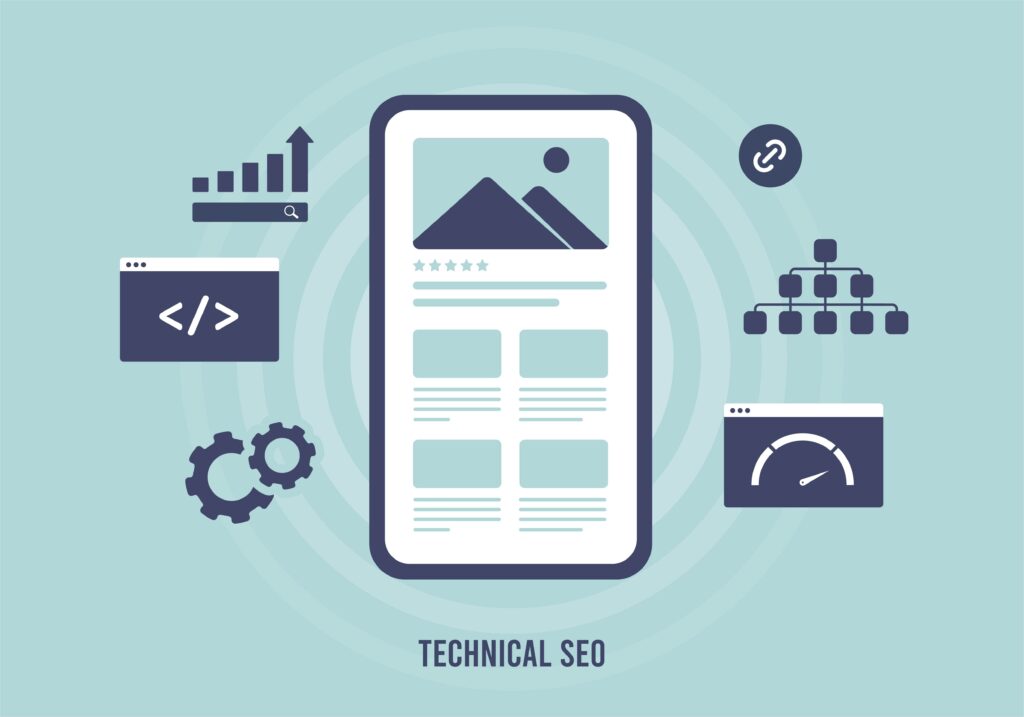
Site Speed: One of the first tenets of technical SEO is site speed. Search engines prefer websites that load quickly, and site speed is a confirmed ranking factor. You can use tools like Google’s PageSpeed Insights to measure your site’s speed and receive tailored recommendations on how to increase it.
Mobile-Friendliness: As more users search on mobile devices, search engines have adopted mobile-first indexing. This means that the mobile version of your website is the one that will be primarily indexed and ranked. Google’s Mobile-Friendly Test can tell you if your site is optimized for mobile viewing.
XML Sitemaps: An XML sitemap is a file that helps search engines understand your website while they are crawling it. It basically lists the URLs of a website in a structured manner, which allows search engines to find pages faster and more efficiently.
SSL Certificates: SSL certificates are a mark of a secure website. Sites that are not secure not only deter users but are also looked down upon by search engines. Therefore, it is important to have an SSL certificate for your site, which you can usually get through your website hosting provider.
Structured Data Markup: Structured data is code that you add to your website’s pages to describe your content to search engines, so they can better understand what’s on your pages. Search engines can use this understanding to display your content in useful (and attractive!) ways in search results.
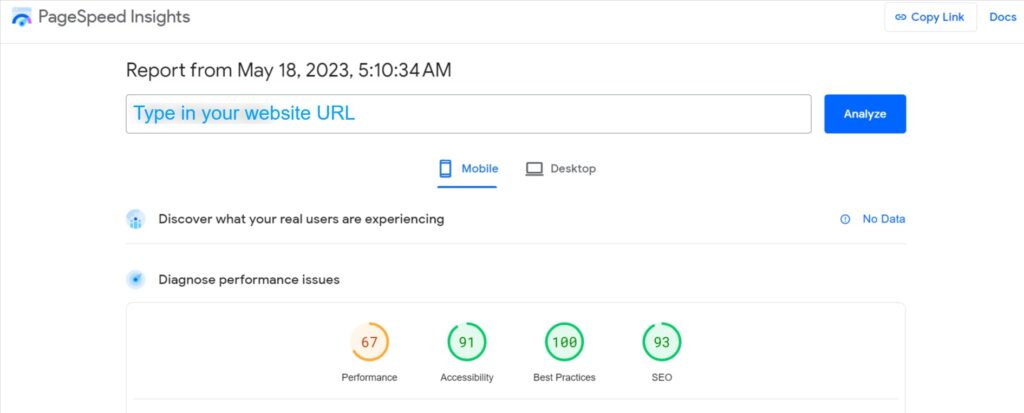
Google’s PageSpeed Insights tool can provide you with a comprehensive report of your website’s load speed. By typing in your website URL, Google will evaluate its loading speed and performance on both mobile and desktop. The results will give you an overview of areas that need improvement, thus aiding in the optimization of your site for better user experience and search engine ranking.
Mobile SEO
In an era where the majority of users access the internet via smartphones, mobile SEO plays an important role in making your site readily available and user-friendly for these users. The aim is to optimize your website so that it fits and functions optimally on the small screens of mobile devices.

Mobile SEO involves several key elements, including responsive design, quick page load times, and user-friendly navigation.
Responsive Design: Responsive design is a web design and development technique that creates a site or system that reacts to the size of a user’s screen. With responsive design, your site will automatically adjust and adapt to any device screen size, whether it’s a desktop, a laptop, a tablet, or a smartphone.
Quick Page Load Times: Mobile users are often on the go, and they expect websites to load quickly. As per Google’s benchmark, a mobile webpage should not take longer than 3 seconds to load. Slow-loading pages can lead to high bounce rates, and this can negatively impact your site’s SEO.
User-friendly Navigation: For mobile users, navigating a website should be hassle-free. This involves easy-to-click buttons, easily accessible menus, and a generally intuitive layout. A complex or frustrating navigation experience can result in visitors leaving your site prematurely, which can, in turn, increase your bounce rate and negatively affect your SEO.
Google’s Mobile-First Indexing: Google now uses mobile-first indexing. This means it predominantly uses the mobile version of the content for indexing and ranking. Previously, the index primarily used the desktop version of a site’s content when evaluating the relevance of a page to a user’s query. With the shift towards mobile-first indexing, failing to optimize for mobile SEO can significantly affect your website’s rankings in search results.
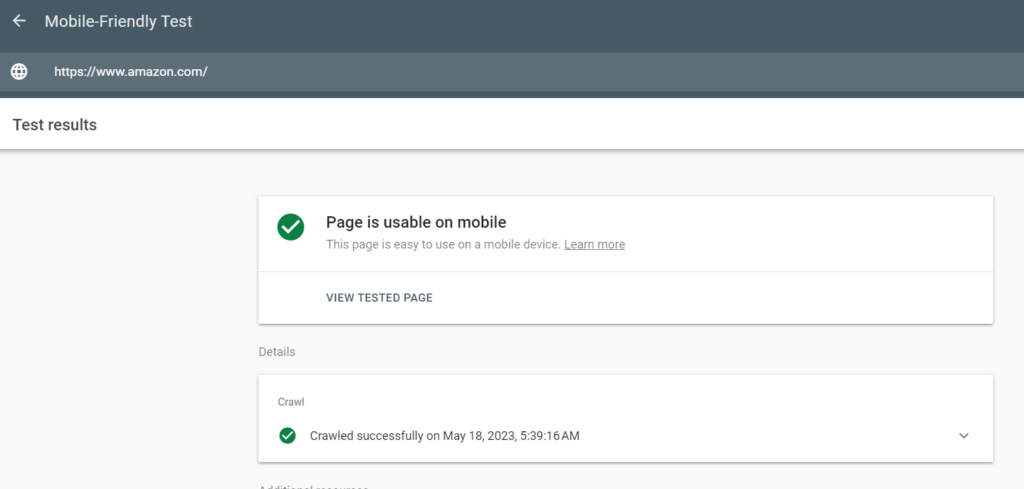
Google’s Mobile-Friendly Test tool can give you an indication of how well your site performs on mobile devices, offering insights and suggestions for improvement. Amazon’s mobile website provides an excellent example of mobile SEO. It has a responsive design, loads quickly, and offers a user-friendly navigation experience.
With the evolution of search behaviors and Google’s continuous updates favoring mobile-friendly sites, investing in mobile SEO is more than just a good practice — it’s a necessity.
Local SEO
Local SEO is a branch of SEO that focuses on optimizing a website to be found in local search results. This strategy holds particular importance for businesses that operate on a regional level, rather than nationally or globally. Think of it as the art of making your business visible to people who are searching for services or products in your vicinity.

The main elements of Local SEO include optimizing your website for location-specific keywords, managing local business listings and directories, and maintaining consistent NAP (Name, Address, Phone number) information across the web. Another key aspect is managing and responding to customer reviews, as they play a significant role in local search rankings.
Table: Key Components of Local SEO
| Component | Description |
|---|---|
| Location-Specific Keywords | Incorporate keywords that reflect your local service area, like "bakery in [city name]" |
| Business Listings and Directories | Make sure your business is listed in local directories and important online platforms like Google My Business |
| NAP Consistency | Your business's name, address, and phone number should be consistent across all online platforms |
| Customer Reviews | Positive reviews can boost your local search rankings. Respond to all reviews, positive and negative, in a timely and professional manner |
| Local Link Building | Earn backlinks from other local businesses, community sites, or local news outlets |
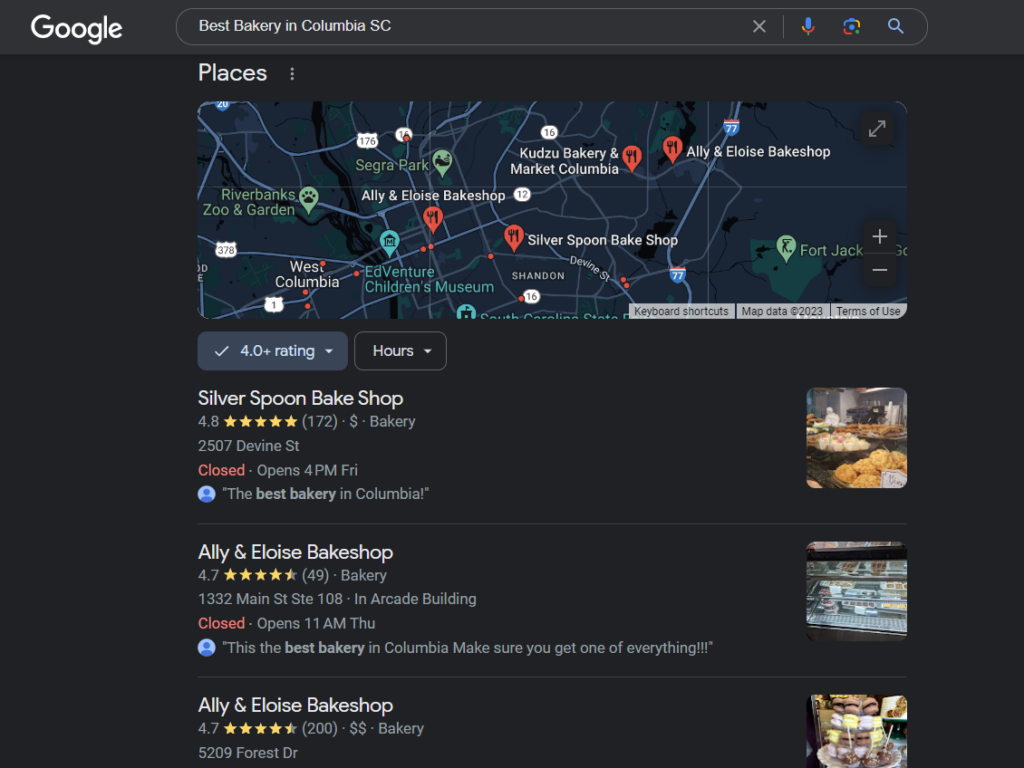
For example, consider a local bakery. They would want their business to appear prominently in search results when a user nearby searches for “bakery near me” or “best bakery in Columbia SC”. This is where Local SEO comes into play.
Organic SEO
Organic SEO is the process of enhancing your website to make it more visible in organic search results, which are the unpaid results that search engines display for a user’s query. With effective Organic SEO strategies, you can improve your website’s relevancy and credibility, thereby improving its position in organic search results. This, in turn, can lead to increased visibility, attracting more high-quality, targeted traffic to your site.
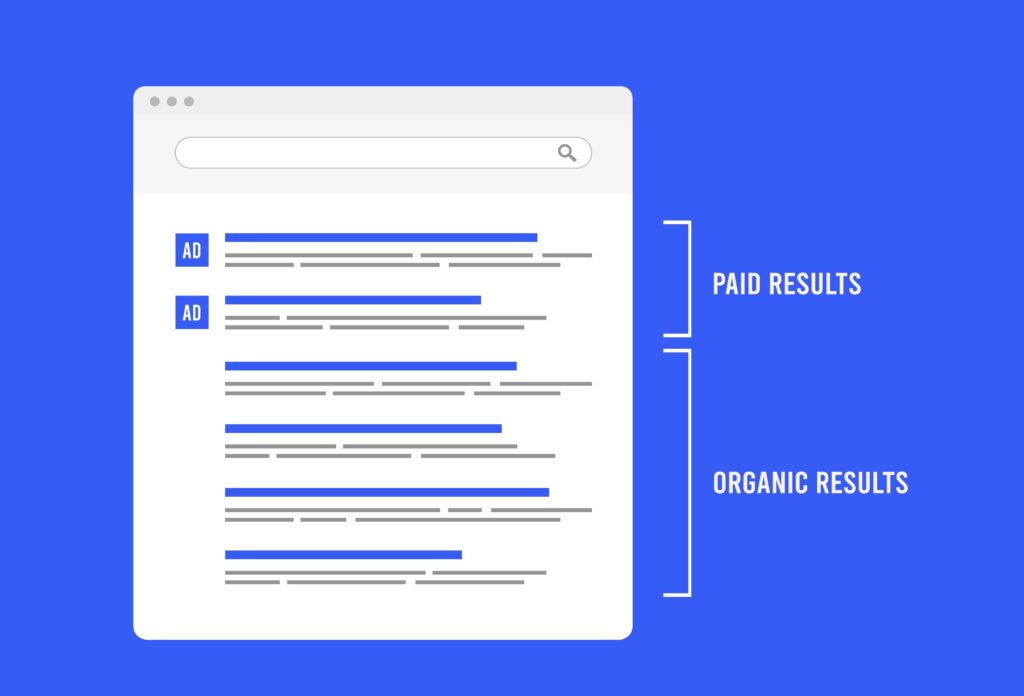
While Organic SEO involves multiple aspects, some of the key elements include:
Content Optimization: Creating high-quality, valuable content that is relevant to your audience’s search queries. This involves incorporating targeted keywords naturally into your content, optimizing page titles, meta descriptions, and headers, and ensuring your content provides real value to users.
Backlinks: A backlink is a link from another website to your site. The quantity and quality of these links contribute to your site’s authority, which can significantly influence its ranking in organic search results. Earning high-quality backlinks from authoritative sites in your industry can boost your site’s credibility in the eyes of search engines.
User Experience: Search engines favor sites that provide a positive user experience. This means your website should be easy to navigate, load quickly, and be mobile-friendly. The more user-friendly your website is, the longer visitors are likely to stay, reducing your site’s bounce rate and potentially improving your organic rankings.
Regular Updates: Search engines favor websites that are regularly updated with fresh content. By consistently adding new content to your site, you signal to search engines that your site is active and relevant.
Table: Different Types of Organic Search Results and their SEO Considerations
| Types of Organic Search Results | SEO Considerations |
|---|---|
| Blue Links | SEO optimized content, appropriate use of keywords |
| Featured Snippets | Direct, concise answers to common queries |
| Image Pack | High-quality, SEO optimized images with appropriate alt text |
| Video Results | High-quality, SEO optimized video content with appropriate metadata |
| Local Pack | Local SEO optimization including NAP consistency |
| News Box | Timely, newsworthy content, sometimes requires Google News approval |
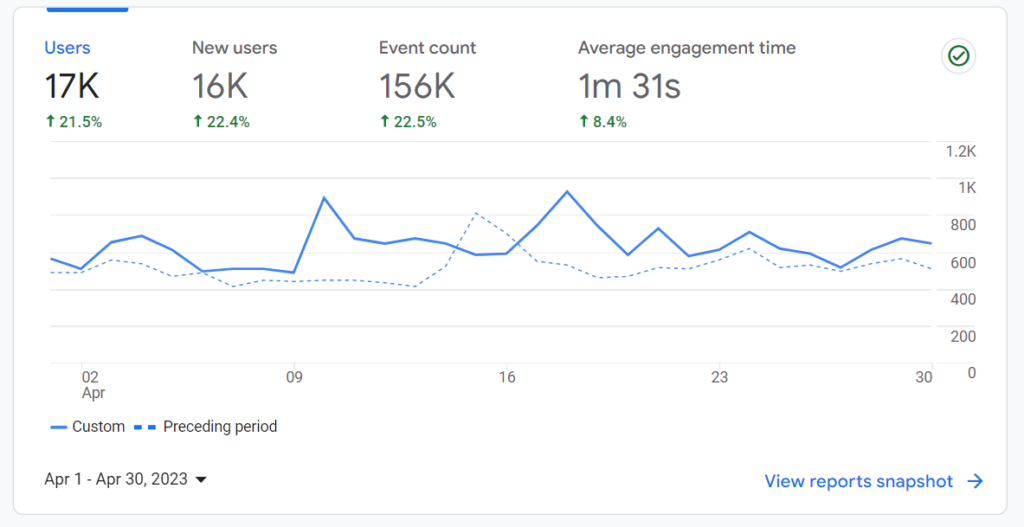
This Google Analytics screenshot represents a snapshot of a company’s organic traffic growth over one month. The company operates in a highly competitive industry. Despite the challenging circumstances, by leveraging high-quality, optimized content, along with earning backlinks from reputable sources and enhancing user experience, they have experienced a noticeable increase in organic traffic. This showcases the effectiveness and potential of a well-executed Organic SEO strategy, even within a relatively short time frame.
Analytics in SEO
Monitoring the performance of your SEO strategy is just as important as developing and implementing it. This is where SEO analytics come into play. SEO analytics involves the collection, processing, and interpretation of data from various sources to understand how users are interacting with your website and where improvements can be made.
Key aspects of SEO analytics include tracking rankings for your target keywords, analyzing website traffic and user behavior, and measuring the impact of your SEO efforts on your overall business objectives. Tools like Google Analytics, Google Search Console, and various third-party solutions can provide valuable insights.
Analytics helps you identify which aspects of your SEO strategy are working well and which need adjustment. For instance, if you notice a drop in organic traffic, it might be due to changes in search engine algorithms or a decrease in backlinks. Similarly, if a specific page on your site is attracting a large number of visitors, it might be worth investing more resources in promoting that content or creating similar content.
Remember, SEO is a long-term strategy, and it’s essential to be patient and consistent. Regularly monitoring and analyzing your SEO performance can ensure that you’re making the most of your efforts and moving in the right direction.
Example: A sudden spike in traffic may indicate that a piece of content has resonated with your audience or that a particular keyword is performing well. Conversely, a dip in traffic might suggest issues with site speed, mobile optimization, or even a penalty from Google.

Table: Key Metrics in SEO Analytics and Their Significance
| Metrics | Significance |
|---|---|
| Organic Search Traffic | Indicates the number of visitors coming from search engines |
| Bounce Rate | Gives an insight into the user engagement on your site |
| Average Session Duration | Reflects the amount of time visitors spend on your site |
| Pages Per Session | Shows the average number of pages viewed during a session |
| Conversion Rate | Measures the percentage of visitors who complete a desired action |
Understanding the basics of SEO is the first step towards improving your website’s visibility and rank on search engines. By applying these principles, you can create a website that is easily discovered and valuable to your target audience. Remember, SEO is not a one-time task, but rather a continuous process that requires regular monitoring and adjustment.
Next in our SEO Series: We’ve just scratched the surface of SEO with this comprehensive overview. Now, are you ready to delve even deeper? Brace yourself, as in our next article, we will be unraveling the mysteries of ‘Keyword Research’ – a core component that can make or break your SEO strategy. Stay tuned!
This concludes the SEO Basics article. I hope this overview has provided you with a solid foundation for understanding the core principles of SEO.
If you’re ready to take your business to the next level, don’t navigate the world of SEO alone. As a leading marketing agency in Columbia, SC, we specialize in crafting tailored SEO strategies to boost visibility, drive traffic, and grow your business. Contact us today to discover how we can turn your SEO goals into a reality. Let’s build your online success story together!






